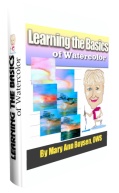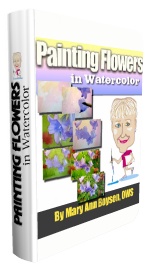Watercolor paper isn't the only surface you can paint on. There are now numerous surfaces on which a watercolorist can paint.
I can remember many years ago, there weren't even any acid free papers on which to paint, and if you see some of the exhibits in museums of famous painters that were doing watercolor sketches in preparation for their oil paintings, the watercolor paper has turned yellowish brown due to the acid content of the fiber. |
|
For many years now, there have been wonderful strides in making paper with cotton and linen fibers. We still call it "paper", but it is actually "rag". It is made in the same way that watercolor paper is made, but not from wood pulp like the original papers used
There are also buffers added to paper to keep it from turning yellow. They are used on wood pulp papers, but the most important thing is that the paper be lignin free. Watercolor paper I have tried and recommend highly (remember that each paper has different qualities and your approach to painting, as well as the result, will be different) are all acid free "rag" papers. Most of them come in 90 lb., 140 lb., 300 lb.
All papers, except Bockingford and the Strathmore Board, are made with different surfaces…..Hot Press (very smooth), Cold Press (slight texture) and Rough (self explanatory!)
- D'Arches: a handmade watercolor paper from France. It has a nice texture and doesn’t appear to have a waffle-iron print on it (as some of the cheaper papers that come in tablets)
- Waterford: made by T.H. Saunders Co from England. This one is made in 200 lb, as well as the other weights. Its texture is very much the same as d'Arches, and is a bit whiter in appearance, allowing for more brilliance to the finished work.
- Bockingford: this is made by St. Cuthbert's Mill in England, and is advertised to be a student grade paper. It is a brilliant white cotton fiber, and feels somewhat like a blotter, but the amazing thing is that it does not absorb the pigments, as do other papers. This allows for more correction by the artist. The downside is that glazing one color over another is very difficult, but can be done carefully. Direct painting works better on this surface than glazing.
- Series #500 Strathmore Illustration Board (paint either side): I discovered this surface for watercolor back in the 1980's when I felt I wanted a change. It is bright white. It also does not absorb the pigment; therefore, corrections are easily made. Glazing is difficult. I painted a series of crystal, broken glass, and shiny subjects on this paper and it was very effective.
- Fabriano: This is an Italian bright white paper and is very popular with many famous artists. It comes in several qualities: Fabriano Artistico, Fabriano Uno, Fabriano Studio, (the most modest price for students). Fabriano has expanded its collection to include one called Soft Press.
- R-TISTX watesrcolor board is a very unique and revolutionary watercolor surface with a proprietary, patented and specially formulated acid-free, archival PH neutral coating. This surface delivers the artist beautiful, bright and true color intensity.
- Claybord®- It comes in a textured and a smooth surface (very difficult to use with watercolor, but possible....see my paintings on this surface and my demo on it.
- Watercolor Canvas, made by Fredrix, another wonderful surface that doesn't require matting and glazing. On this site you will see many paintings on this surface. One of my e-books discusses it in detail.
|
My E-Books

Learning the Basics of Watercolor

Painting Flowers in Watercolor

Painting on Watercolor Canvas |

